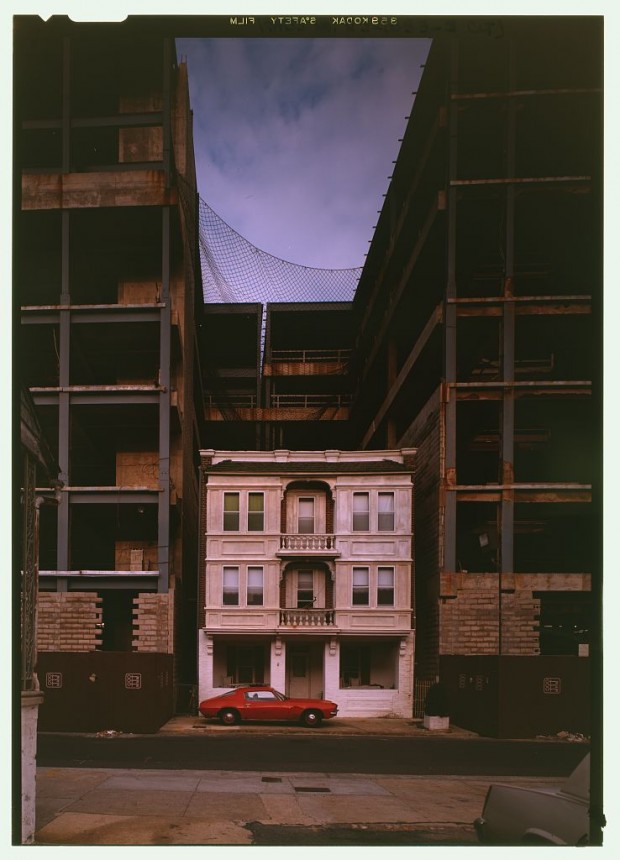An iconographic and text archive related to communication, technology and art.
☛ Library of Congress, Prints & Photographs Division, HABS: “View of house between two casinos” by Jack E. Boucher, medium: 5 x7, date unknown. Call Number: HABS NJ,1-ATCI,19–3 (CT). This photo belongs to the survey Town of Atlantic City, North end of Absecon Island, South of Absecon Channel, Atlantic City, Atlantic County, NJ. This photo is in the Public domain.
The photograph is stunning in many ways. Among other things, it seems to articulate a variety of contrasts. The dark structures of the casinos under construction help accentuate both the patch of sky above and the white brick house under it. This house is dwarfed and squeezed by the gigantic buildings growing beside it. However, although it looks old and classic with its centred balustrades ―while the casinos suggest a more modern architecture― the presence of the sport car could be read like a statement of continuity. The car is an architectural object of its own: here, it looks like a red hyphen between two world colliding.
This undated photo was taken by Jack E. Boucher who passed away recently, on September 2, 2012. He was Chief Photographer for the famous Historic American Buildings Survey (HABS) and work as well for two related projects: the Historic American Engineering Record (HAER) and Historic American Landscapes Survey (HALS).
From the National Trust for Historic Preservation blog:
The National Park Service’s Historic American Buildings Survey (HABS) is the nation’s first federal preservation program, launched in 1933 as a way of documenting the nation’s architectural heritage. For half a century Jack Boucher traveled the United States for HABS photographing what NPS calls “a complete resume of the builder’s art.”
He also photographed places for the Historic American Engineering Record and the Historic American Landscape Survey. But today, his images are appreciated as more than just documents of historic places; they are appreciated as art.
Lauded by preservationists and photographers alike, Boucher’s photographs of colonial-era mansions, civic monuments, structures designed by the greatest American architects, and vernacular buildings help define our evolution as a nation as well as the diverse regions we call home.
His career took him to 49 states, the Virgin Islands, and Puerto Rico, and he produced thousands of images, all of which are public domain and available through the Library of Congress. (read more: “Remembering Jack Boucher, Photographer and Preservationist” by Dennis Hockman, September 10, 2012)
In an interview he gave to The Post and Courier in 1995, he talked about his philosophy:
He has photographed thousands of buildings – from the White House to an outhouse, from The Battery to a Hawaiian leper colony. National Park Service photographer Jack E. Boucher said his negatives are expected to survive for centuries, but he hopes most of them will never have to be put to use. When they are, it usually means the United States has lost another architectural treasure.[…]
He declined to say which building was his favorite subject. “My whole philosophy is I regard the building I’m doing as the most important one in my life, even if it’s a single-seat log outhouse.” (read more: “Photographer hopes his work’s never needed” by Robert Behre, Section A, Edition SA, page 17, March 4, 1995)
More information online:
-
I first found this photo while reading Picture This, one of the Library of Congress numerous blogs. See: “The Visual Legacy of Jack E. Boucher, Architectural Photographer” by Kristi Finefield, November 15, 2012.
-
One can search the Historic American Buildings Survey archive for more photos by Jack E. Boucher simply by using the key words “Jack Boucher”. As of now (Nov. 2012) it will return 17,706 positive results.
-
For a more thorough analysis of the architectural significance of the particular survey to which this photo belongs, see the accompanying document HABS No. NJ-1033 (PDF) prepared by HABS historian Camille Gatza in the Summer of 1991. Excerpt:
Atlantic City, the most famous of the speculative New Jersey resorts, conceived in the 1850s, was the first resort created in conglomeration with the railroad industry and signaled the opening of the shore to extensive growth. The support of railroad investors and local manufacturers made possible the construction of Camden and Atlantic railroad in order to create the ideal resort. While Atlantic City has become analogous with the “boardwalk” resort, today the boardwalk is lined with glitzy casinos, amidst a contrasting destitute urban community.
-
The Washington Post: “Jack E. Boucher, longtime National Park Service photographer, dies at 80” by Megan McDonough, September 13, 2012.
-
See also Wikipedia and more photos by Jack E. Boucher at Wikimedia Commons.
- By Philippe Theophanidis
- on
- ― Published in Architecture, Art, Photography
- Tagged: America, archive, Atlantic City, building, car, casino, city, construction, history, Jack E. Boucher, modern, modernity

